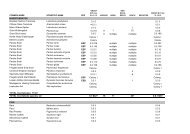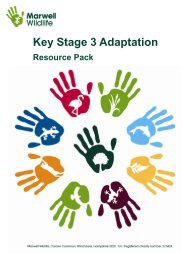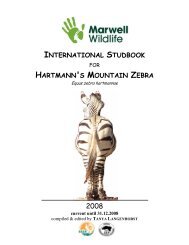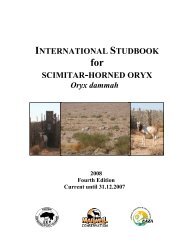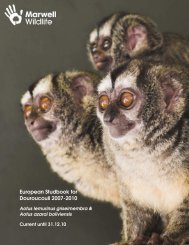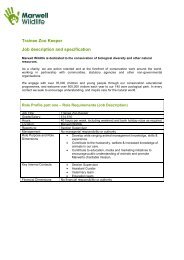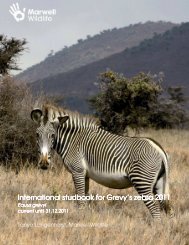KS2 Adaptation Resource Pack - Marwell Wildlife
KS2 Adaptation Resource Pack - Marwell Wildlife
KS2 Adaptation Resource Pack - Marwell Wildlife
Create successful ePaper yourself
Turn your PDF publications into a flip-book with our unique Google optimized e-Paper software.
Key Stage 2 <strong>Adaptation</strong><br />
<strong>Resource</strong> <strong>Pack</strong>
Contents Page<br />
Introduction 1<br />
Summary of resources 1<br />
Preparation before your visit 2<br />
<strong>Adaptation</strong> trail<br />
Student booklet 3-10<br />
Map (last page of booklet) 10<br />
Cold-blooded Corner Mini-trail<br />
Student worksheet 11<br />
Tropical World Activity – Who Am I?<br />
Student worksheet 12<br />
Animal Passport (student booklet) 13 -16<br />
<strong>Adaptation</strong> Dominoes (15 cards) 17-24<br />
Activity Sheet Answers 25<br />
<strong>Adaptation</strong> Trail Answers 25<br />
Cold-blooded Corner Mini-trail Answers 26<br />
Tropical World Activity – who am I? Answers 26<br />
<strong>Adaptation</strong> Word Cards 27<br />
Reference list 28<br />
Evaluation 28
Introduction<br />
This resource has been produced to support the teaching and learning of the<br />
Key Stage 2 <strong>Adaptation</strong>s topic. It contains a number of activities that can be<br />
used in a variety of ways:<br />
• In school as part of your Scheme of Work<br />
• During an independent park visit to <strong>Marwell</strong> <strong>Wildlife</strong><br />
• As part of a visit to <strong>Marwell</strong> <strong>Wildlife</strong> that also involves the <strong>KS2</strong><br />
<strong>Adaptation</strong> session run by the Science and Learning Centre.<br />
The resource contains:<br />
• an <strong>Adaptation</strong> Trail around <strong>Marwell</strong><br />
• two activities that can be used at specific sites in the park (Coldblooded<br />
Corner and Tropical World)<br />
• an Animal Passport for your favourite animal<br />
• an interactive game: <strong>Marwell</strong> Dominoes.<br />
National Curriculum links:<br />
Sc2.5b: Know about the different plants and animals found in different<br />
habitats.<br />
Sc2.5c: Know how animals and plants in two different habitats are suited to<br />
their environment.<br />
Summary of <strong>Resource</strong>s<br />
<strong>Adaptation</strong> Trail – for use on a visit<br />
The <strong>Adaptation</strong> Trail is a journey of discovery through <strong>Marwell</strong> which allows<br />
students to develop and apply their knowledge and understanding of<br />
‘adaptation’. It follows the main route around the park, taking in twelve<br />
species from a range of habitats; this provides students with the opportunity to<br />
see and consider a range of adaptations. The route of the trail will pass toilet<br />
blocks and there is a picnic site and café approximately half way round to<br />
allow for a break or for lunch.<br />
Cold-blooded Corner Mini-trail – for use on a visit<br />
This can be added on to the main trail or done as a stand-alone sheet. It<br />
focuses upon some of the reptiles found in Cold-Blooded Corner at Encounter<br />
Village. The students link together the picture of the reptile, its name and its<br />
adaptations by looking at the animals and finding the correct information,<br />
clues for which should be available on the information signs.<br />
Tropical World Activity - Who am I? – for use on a visit<br />
This clue-based activity is designed for the Tropical House. Students have to<br />
look at the different species within the tropical house and determine which<br />
species is the answer to the clues. There are different versions of this sheet<br />
within the pack to reduce overcrowding. Please note that there is a one-way<br />
1
oute around the Tropical House and that students should be forewarned not<br />
to touch the plants as some of them are poisonous.<br />
Animal Passport – for use on a visit or in the classroom<br />
This is a worksheet that provides a framework for students to use in order to<br />
discover more about their favourite animal’s adaptations. This can be used<br />
while visiting <strong>Marwell</strong> wildlife or as part of an internet-based research project.<br />
<strong>Adaptation</strong> Dominoes – classroom based<br />
This consists of 15 domino cards to print out; each one with an animal photo<br />
on one half and the adaptations of a different animal on the other half,<br />
which need to be matched in turn. This could be played in groups and could<br />
be used as a starter or a plenary activity.<br />
Before your Visit<br />
It may be useful to familiarise yourself and the students with the variety of<br />
animals that we have here at <strong>Marwell</strong> <strong>Wildlife</strong>. Our website<br />
(www.marwell.org.uk) might be helpful and there are other links at the end of<br />
this document.<br />
If you are doing a trail round the park, students can use the information<br />
provided on signs, some picture clues on trail sheets and their own<br />
observations to complete their worksheets. A word card is included at the<br />
end of the pack to assist less able students.<br />
Please note that crested porcupines and black and white colobus monkeys<br />
are currently in the same enclosure. Giraffes have an indoor enclosure, where<br />
they will be in winter and wet weather, and two outdoor paddocks, in both of<br />
which there should be giraffes in good summer weather. The other animal<br />
which moves its location regularly is the camel, which has a winter and a<br />
summer paddock – the summer one is near the playground. These are all<br />
marked on the map in the <strong>Adaptation</strong> Trail Booklet.<br />
This booklet (and the Animal Passport) can be printed out either on A4 sheets<br />
or in booklet format. The <strong>Adaptation</strong> Trail Booklet includes a map.<br />
2
Welcome to <strong>Marwell</strong> <strong>Wildlife</strong>!<br />
Name ________________________________________<br />
School _______________________________________<br />
<strong>Adaptation</strong> Trail<br />
You are about to go on a journey of discovery around the park to<br />
find out more about how different animals are suited to their<br />
environment. First, let’s make sure that you know what these words<br />
mean: match up the word and what it means using a line.<br />
camouflaged<br />
predator<br />
prey<br />
habitat<br />
adapted<br />
This is the environment (place) where<br />
an animal or plant lives.<br />
This means that the animal can blend<br />
into its surroundings.<br />
This means that the animal/plant has<br />
features that allow it to live in its<br />
habitat.<br />
These are animals that are eaten by<br />
other animals.<br />
These animals eat other animals.<br />
On your journey around the park, you will meet some amazing<br />
animals and have some challenges to complete on your way.<br />
<strong>Adaptation</strong> Trail Booklet - page 1
Some of the information you will need is on signs on the enclosure;<br />
sometimes you have to watch the animal and look at the photos<br />
and picture clues to work out the answers.<br />
1. HUMBOLDT PENGUIN<br />
What habitat does it live in? _____________________________________<br />
________________________________________________________________<br />
What are their wings like? _______________________________________<br />
What other features help these birds to live?<br />
2. PORCUPINE<br />
____________________________________________<br />
____________________________________________<br />
____________________________________________<br />
____________________________________________<br />
____________________________________________<br />
The habitats it lives in are ________________________________________<br />
________________________________________________________________<br />
Its most obvious adaptation is its _________________________________<br />
These help it to survive because _________________________________<br />
________________________________________________________________<br />
3. BLACK AND WHITE COLOBUS MONKEY<br />
<strong>Adaptation</strong> Trail Booklet - page 2
3. BLACK AND WHITE COLOBUS MONKEY<br />
What type of habitat do they live in? ____________________________<br />
________________________________________________________________<br />
These monkeys have long arms and a long tail. How do these<br />
adaptations help them to survive in the forests where they live?<br />
________________________________________________________________<br />
________________________________________________________________<br />
4. GIRAFFE<br />
This is the tallest land animal in the world.<br />
What habitat does this animal live in? ___________________________<br />
________________________________________________________________<br />
What adaptations does it have that make it into the tallest animal?<br />
________________________________________________________________<br />
________________________________________________________________<br />
Give two reasons why being so tall is useful for a giraffe.<br />
1. ___________________________________________________________<br />
2. ___________________________________________________________<br />
A giraffe’s tongue is 46-50cms long. How does this help it?<br />
____________________________________________________<br />
____________________________________________________<br />
<strong>Adaptation</strong> Trail Booklet - page 3
5. SAND CAT<br />
Which habitat does it live in? ____________________________________<br />
Using the information board, answer these questions to discover<br />
more about this animal’s special fur:<br />
How hot does it get during the day in the Sahara? _____________ºC<br />
How cold does it get at night in the Sahara? ___________________ºC<br />
What is special about the fur? ___________________________________<br />
What does this animal do to help it survive these harsh<br />
temperatures?<br />
________________________________________________________________<br />
________________________________________________________________<br />
6. SERVAL<br />
What habitat does it live in? ____________________________________<br />
Have a close look at this wild cat. Do you think it would be<br />
camouflaged in its natural environment?<br />
_______________________<br />
Write down two other adaptations and how you<br />
think they help the serval survive.<br />
1. ______________________________________________<br />
It helps because_________________________________<br />
2. ______________________________________________________________<br />
It helps because________________________________________________<br />
________________________________________________________________<br />
<strong>Adaptation</strong> Trail Booklet - page 4
7. COATI<br />
What type of habitat does it live in? _____________________________<br />
Name 2 features that help it to live there:<br />
____________________________________________________<br />
____________________________________________________<br />
What special feature does this animal have that allows it<br />
to walk down trees head first?<br />
________________________________________________________________<br />
8. CAMEL This species has two possible locations on the map,<br />
depending on the season. It is near Encounter Village in winter.<br />
Which habitat is the camel adapted for? _______________________<br />
Look at this animal’s feet. Describe what they look like and how<br />
they help it to survive.<br />
__________________________________________________<br />
__________________________________________________<br />
The camel is able to use a special area of its body to store fat,<br />
which it can change into water when it needs it. What is this<br />
called?<br />
________________________________________________________________<br />
Have a look at this animal’s face. How could the eye-<br />
lashes and nostrils help to protect it in a sand storm?<br />
Eyelashes: __________________________________________<br />
Nostrils: _____________________________________________<br />
____________________________________________________<br />
<strong>Adaptation</strong> Trail Booklet - page 5
9. SULAWESI CRESTED MACAQUE<br />
What habitat do they live in? ____________________________________<br />
What special features do the macaques have?<br />
Choose two features and see if you can work out how these<br />
features might help the macaques in the wild.<br />
1._______________________________________________________________<br />
__<br />
_______________________________________<br />
_______________________________________<br />
2._____________________________________<br />
______________________________________<br />
________________________________________________________<br />
10. SIAMANG GIBBON<br />
In which type of habitat can it be found? ________________________<br />
What adaptations does it have to help it move through the trees<br />
easily?<br />
____________________________________________<br />
____________________________________________<br />
____________________________________________<br />
____________________________________________<br />
____________________________________________<br />
<strong>Adaptation</strong> Trail Booklet - page 6
11. SNOW LEOPARD<br />
What type of habitat does it live in? _____________________________<br />
Look at this animal. What three adaptations help it to live in its<br />
habitat?<br />
1.____________________________________________________<br />
It helps to____________________________________________<br />
2.____________________________________________________<br />
They help it to ____________________________________________<br />
3.____________________________________________________<br />
This helps it to balance.<br />
12. GIANT ANTEATER<br />
What habitat does this animal live in: ____________________________<br />
What type of food does this animal eat? _________________________<br />
What two adaptations can you see that would help it to feed?<br />
1.________________________________________________<br />
It helps because _________________________________<br />
2.________________________________________________<br />
These help because ______________________________<br />
__________________________________________________<br />
<strong>Adaptation</strong> Trail Booklet - page 7
4<br />
8<br />
5<br />
6<br />
10<br />
7<br />
2,3<br />
4<br />
8<br />
4<br />
1<br />
9<br />
10<br />
12<br />
11
Cold-blooded Corner Mini-trail: Look at the amazing reptiles in the exhibit and see if you can match up<br />
the picture, name and adaptations. Use four different lines (e.g. - - - - - or __________ or a wavy line or<br />
zig-zag line) or four different colours to match them up. Look at the signs to see where in the world each<br />
one lives and what it eats, to help you choose the matching boxes.<br />
What am I?<br />
Egyptian<br />
tortoise<br />
Gila monster<br />
Madagascan<br />
tree boa<br />
Panther<br />
chameleon<br />
What adaptations (special features) do I have?<br />
I store fat in my tail<br />
for use in winter<br />
months, in western<br />
U.S. deserts.<br />
I have a hard shell<br />
to protect against<br />
predators.<br />
My long tongue with<br />
a sticky tip shoots<br />
out very fast to<br />
catch insects.<br />
I kill my prey by<br />
tightening my<br />
powerful coils<br />
round the victim’s.<br />
11<br />
Small round size<br />
helps me to heat up<br />
quickly in the sun,<br />
after a cold night in<br />
the desert.<br />
I eat small<br />
mammals and birds,<br />
opening my jaw<br />
wide to swallow<br />
animals whole<br />
My red, green and<br />
white skin colour<br />
changes for<br />
camouflage or to<br />
show my moods<br />
My short back legs<br />
with long claws help<br />
to dig up a meal or<br />
make a burrow.<br />
I am green, grey<br />
and black – good<br />
camouflage to live<br />
in forests!<br />
My striking green<br />
and black colouring<br />
warns that I am<br />
venomous.<br />
My claws are good<br />
for digging and<br />
burying my eggs in<br />
the sand in<br />
North Africa<br />
Each of my eyes<br />
can look round on<br />
its own, which<br />
helps me find.
Tropical World - Who am I?<br />
Read the clues and track down these amazing plants and animals found in<br />
the Tropical World whilst discovering more about how they are adapted<br />
(suited) to where they live (their habitat).<br />
Name ______________________________________<br />
• I have 6 stalk-like legs<br />
• I am green/grey and<br />
small<br />
• I am very well<br />
camouflaged<br />
• My head looks similar<br />
to that of a horse<br />
I am a..........................<br />
……………………...……<br />
……………………….......<br />
1<br />
• I am very small<br />
• I have six legs<br />
• I don’t live alone<br />
• I have a special<br />
job that helps my<br />
colony to survive<br />
I am a............................<br />
.……………………...........<br />
………………………........<br />
4<br />
• I have 4 legs<br />
• I have a long tail<br />
• I have claws that I can<br />
use to climb trees<br />
• I have a special flaps<br />
of skin behind my<br />
head that I can open<br />
into a fan to scare off<br />
attackers and to lose<br />
heat.<br />
I am a...........................<br />
..........……………..........<br />
……………………………<br />
2<br />
• I have four legs<br />
• I have rough scaly<br />
skin<br />
• When I float in the<br />
water, I leave only my<br />
nostrils, eyes, and ears<br />
above the surface.<br />
• I have a powerful tail<br />
to help me swim, and<br />
many sharp teeth.<br />
I am a............................<br />
........................................<br />
5<br />
12<br />
• I am green and<br />
black<br />
• I am not well<br />
camouflaged<br />
• My colour warns<br />
predators that I am<br />
poisonous<br />
• My skin is smooth<br />
and moist<br />
I am a …………………...<br />
…………………………....<br />
....................................<br />
3<br />
• I am a climbing plant<br />
• I have small extra<br />
roots to attach to<br />
tree trunks<br />
• My leaves get bigger<br />
nearer the top, to use<br />
the available light<br />
• I have thick, waxy<br />
leaves so that I don’t<br />
lose too much water<br />
I am a ..…………........<br />
……….........................<br />
....................................<br />
6
Animal Passport<br />
My favourite animal at <strong>Marwell</strong> <strong>Wildlife</strong> is:<br />
________________________________________________________________<br />
Draw your animal in here<br />
My name is: ____________________________________________________<br />
My school is: ____________________________________________________<br />
Animal Passport – Page 1
Animal Details<br />
Fill in this passport by looking at your animal and using the<br />
information sign.<br />
Where in the world does your animal come from?<br />
______________________________________________________________<br />
In the questions below, circle the best answer or answers for your<br />
chosen animal.<br />
Animal Group<br />
My animal has:<br />
FUR/HAIR SMOOTH WET SKIN<br />
This means that my animal is a:<br />
FEATHERS SLIMY SCALES<br />
DRY SCALES<br />
AMPHIBIAN REPTILE MAMMAL<br />
Habitat<br />
BIRD FISH<br />
What kind of place does your animal live in?<br />
WARM COLD<br />
HOT DRY WET<br />
Animal Passport – Page 2
Size:<br />
My animal is:<br />
LARGE MEDIUM SMALL<br />
How might this help your animal live in its habitat?<br />
________________________________________________________________<br />
________________________________________________________________<br />
Camouflage<br />
Many animals are able to blend in with their home due to their<br />
colour. This is called camouflage.<br />
What colour is your animal? _____________________________________<br />
Is it camouflaged? Yes No<br />
Why do you think would this be helpful? _________________________<br />
________________________________________________________________<br />
Other <strong>Adaptation</strong>s:<br />
Special features, like the type of fur, claws or teeth, for example,<br />
can help an animal live in its habitat. These are known as<br />
adaptations.<br />
What adaptations does your animal have to help it live there?<br />
________________________________________________________________<br />
________________________________________________________________<br />
________________________________________________________________<br />
Animal Passport – Page 3
Write down one more special thing about your favourite animal;<br />
maybe what makes you like it best?<br />
________________________________________________________________<br />
________________________________________________________________<br />
________________________________________________________________<br />
What else would you like to know about your animal?<br />
________________________________________________________________<br />
________________________________________________________________<br />
We hope that you have had a lovely time visiting us and the<br />
animals here at <strong>Marwell</strong> <strong>Wildlife</strong>.<br />
What else have you discovered during your visit?<br />
________________________________________________________________<br />
________________________________________________________________<br />
________________________________________________________________<br />
________________________________________________________________<br />
Animal Passport – Page 4
<strong>Adaptation</strong> Dominoes<br />
There are 15 dominoes in the pack. The picture on one domino links to the<br />
information on another. They should end up as a loop at the end when they<br />
are all matched up.<br />
You may wish to print out 2 sets, divide your class into two groups and let<br />
them compete to finish the dominoes in the quickest time.<br />
Humboldt Penguin<br />
Serval<br />
Crested Porcupine<br />
17<br />
• I have small spots to camouflage<br />
in savannah grasses.<br />
• My long, slim legs help me run very<br />
fast.<br />
• I have a small head which helps<br />
me to be streamlined for speed<br />
• My long tail helps me to change<br />
direction, when I am chasing my<br />
prey<br />
• My wings are like flippers and help<br />
me swim.<br />
• I have waterproof feathers.<br />
• My body is a streamlined shape to<br />
help me swim through the water.<br />
• I have black and white feathers so<br />
that predators cannot see me<br />
from above and below.<br />
• My beak has special teeth to hold<br />
the fish that I catch for food.<br />
• My light brown coat with black<br />
spots helps me to blend in with my<br />
habitat.<br />
• I live in grasslands or savannahs.<br />
• My long legs help me to jump into<br />
the air to catch birds and to run<br />
fast.<br />
• I have very large ears so that I can<br />
hear my prey.
Giraffe<br />
Ring-tailed coati<br />
Bactrian camel<br />
Black and white<br />
colobus monkey<br />
19<br />
• I have very long quills that are very<br />
sharp.<br />
• My quills are hollow so when I am<br />
scared I can shake them to make<br />
a loud rattle sound.<br />
• If I am being attacked, I run<br />
backwards at my attacker and<br />
stick my quills in them.<br />
• I am mostly black with a very long<br />
white tail.<br />
• I use my long tail to help me move<br />
through the trees.<br />
• My long arms help me to swing<br />
from tree to tree.<br />
• I have long fingers that I use to grip<br />
onto branches.<br />
• I am light brown with darker<br />
patches that look like crazy<br />
paving.<br />
• My tongue is very long to help me<br />
reach food and it is blue.<br />
• My lips are very tough as I like to<br />
eat leaves off very prickly trees.<br />
• I am very tall as I have very long<br />
legs and a very long neck.<br />
• I have strong legs and claws to<br />
help me move around woodland<br />
areas.<br />
• I use my tail to help me to balance<br />
as I walk along branches.<br />
• My snout (nose) is very flexible.<br />
• My ankles can move 180º so that I<br />
can see below me when I am<br />
walking down trees.
Panther chameleon<br />
Tokay gecko<br />
Horse-headed grasshopper<br />
Sand cat<br />
21<br />
• I can have a thick coat in winter to<br />
keep me warm and a thin coat in<br />
the summer to help me to stay<br />
cool.<br />
• My nostrils can be closed during<br />
dust storms.<br />
• I can drink up to 57 litres of water<br />
in one go.<br />
• I have two humps where I store my<br />
fat.<br />
• I have special hairs on my toes<br />
that help my feet stick to any<br />
surface, even glass.<br />
• If I feel threatened I can drop my<br />
tail which will act as a distraction<br />
whilst I escape.<br />
• My eyes work separately to each<br />
other so I can see all around me.<br />
• I have a special long tongue that I<br />
use to stun and grab my prey.<br />
• My toes allow me to grip onto<br />
small branches.<br />
• I can change my colour to make<br />
me camouflaged or to show my<br />
mood.<br />
• I live in sandy deserts.<br />
• My fur is very special as it is so thick<br />
that it protects me from freezing<br />
temperatures at night and very hot<br />
temperatures during the day.<br />
• I have strong legs so I can dig out<br />
prey and make burrows for me to<br />
shelter in.
Poison arrow frog<br />
Poison dart frog<br />
Siamang gibbon<br />
Snow leopard<br />
Cheetah<br />
23<br />
• I am light brown so that I am<br />
camouflaged.<br />
• I am very small.<br />
• I look like the twigs on which I live.<br />
• I am an insect.<br />
• I spend most of my time up in the<br />
canopy of the forest.<br />
• My legs are much shorter than my<br />
arms, which helps me to move<br />
from branch to branch.<br />
• When I am on the ground I walk<br />
with my arms above my head to<br />
help me balance.<br />
• I have black hair.<br />
• I am camouflaged against the<br />
mountain where I live.<br />
• My feet are very wide which helps<br />
me to move through the snow and<br />
across rocks.<br />
• I have a very long and fluffy tail<br />
that I use for balance and to keep<br />
my face warm when I am asleep.<br />
• I am not a mammal.<br />
• I am small and live in the tropical<br />
rainforests.<br />
• My colouring means that I am not<br />
well camouflaged.<br />
• My black and green colour tells<br />
predators that they shouldn’t eat<br />
me as I am poisonous.
Activity Answers<br />
<strong>Adaptation</strong> Trail - Answers<br />
1. Humboldt penguin: Habitat: Rocky coasts and cool waters<br />
Wings: Act as flippers to help them swim.<br />
Other features: Beak has small teeth to keep hold of fish; waterproof<br />
feathers; streamlined body; camouflage.<br />
2. Crested porcupine: Habitats: Many habitats from forest to desert<br />
Obvious adaptation: Quills<br />
Reason: defend against predators, can shake them to make them rattle or<br />
run at attacker and stick quills into them.<br />
3. Black and white colobus monkey: Habitat: Tropical rainforest<br />
Long arms and tail: Swing between trees, move along branches, tail acts as<br />
brake or used for balance; reach food.<br />
4. Giraffe: Habitat: Savanna or dry, open country and woodland<br />
Features to make it tall: Long legs and long neck.<br />
Two reasons: Help it to reach food; can see danger.<br />
Tongue: Can grab and pick leaves to eat.<br />
5. Sand cat: Habitat: Sandy desert<br />
How hot?: 58°C<br />
How cold?: -5°C or -25°C (winter)<br />
Special fur: Solid, dense fur that insulates them.<br />
Other survival strategy: Digs burrows to get shade, using strong legs.<br />
6. Serval: Habitat: Savanna<br />
Camouflage: Yes<br />
Possible adaptations: Large ears – to hear prey/lose heat; long legs – to run<br />
fast/to jump; claws/sharp teeth – to catch/eat prey.<br />
7. Coati: Habitat: Forests and woods<br />
Features: Strong short legs and claws to help it climb; narrow nose to search<br />
for food; thick fur to keep it warm; long tail to help with balance.<br />
Special feature: (found on information board) they can turn their ankles 180°.<br />
8. Camel: Habitat: Semi-arid to arid plains, grasslands and desert<br />
Feet: Wide toes, spread out weight to stop sinking in sand.<br />
Fat store: Hump<br />
Facial features: Long eye-lashes keep sand out of eyes; nostrils are like slits<br />
that can open and close.<br />
9. Sulawesi crested macaque: Habitat: Tropical forest<br />
Special features: Crest on head, for communication - raises when anxious or<br />
alarmed; pink bottom: on male and female, perhaps helps them see each<br />
other in forest - on female becomes bigger when she is ready to breed;<br />
cheek pouches: can hold as much food as stomach, to eat later in safety.<br />
10. Siamang gibbon: Habitat: Tropical rainforest<br />
Features: Long arms for swinging; long fingers to grip branches; forward facing<br />
eyes to judge distances.<br />
11. Snow Leopard: Habitat: Cold mountains<br />
<strong>Adaptation</strong>s: Thick fur to protect against the cold; large paws to move easily<br />
through snow; strong legs/paws to catch prey and move easily through rocky<br />
25
areas; long tail to help with moving through rocky areas; furry tail can be<br />
wrapped over the face to keep it warm when resting; large teeth for killing<br />
and eating prey.<br />
12. Giant Anteater: Habitat: Grasslands and forests<br />
Diet: Ants, beetles, termites and fruit.<br />
<strong>Adaptation</strong> and reasons: Strong legs and claws to reach ants/termites; long<br />
nose to sense ants/termites.<br />
Cold-blooded Corner Mini-trail – Answers<br />
Panther chameleon:<br />
• My long tongue with a sticky tip shoots out very fast to<br />
catch insects.<br />
• My red, green and white skin colour changes for<br />
camouflage or to show my moods.<br />
• Each of my eyes can look round on its own, which helps me find insect<br />
food.<br />
Egyptian tortoise:<br />
• I have a hard shell to protect against predators.<br />
• Small round size helps me to heat up quickly in the sun<br />
after a cold night in the desert.<br />
• My claws are good for digging and burying eggs in the sand in North<br />
Africa.<br />
Gila monster:<br />
• I store fat in my tail for use in winter months, in western<br />
U.S. deserts.<br />
• My short black legs with long claws help to dig up a<br />
meal or make a burrow.<br />
• My striking pink and black colouring warns that I am venomous.<br />
Madagascar tree boa:<br />
• I kill my prey by tightening my powerful coils round the victim’s body.<br />
• I eat small mammals and birds, opening my jaw wide to swallow<br />
animals whole<br />
• I am green, grey and black – good camouflage to live in forests!<br />
Tropical World Activity – Who Am I? - Answers<br />
1. Horse-headed grasshopper<br />
2. Frilled lizard<br />
3. Poison arrow frog<br />
4. Leaf-cutter ant<br />
5. West African dwarf crocodile<br />
26
6. Devil’s ivy<br />
<strong>Adaptation</strong> Word Card<br />
ankles beak bottom cheek 34 claws ears feet<br />
fingers flippers fur eyes hump legs neck paws<br />
pouches quills snout stomach tail ant leaves<br />
rocks prey predator termite trees alarmed<br />
anxious bushy fat forward-facing large long<br />
raised small streamlined strong thick thin visible<br />
webbed attack balance camouflage catch defend<br />
keep warm pick reach swing swim spread weight<br />
Habitats (where they live)<br />
desert savannah tropical rainforest grassland<br />
arid/semi-arid plains mountains woodlands<br />
<strong>Adaptation</strong> Word Card<br />
ankles beak bottom cheek claws ears feet<br />
fingers flippers fur eyes hump legs neck paws<br />
pouches quills snout stomach tail ant leaves<br />
rocks prey predator termite trees alarmed<br />
anxious bushy fat forward-facing large long<br />
raised small streamlined strong thick thin visible<br />
webbed attack balance camouflage catch defend<br />
keep warm pick reach swing swim spread weight<br />
Habitats (where they live)<br />
desert savannah tropical rainforest grassland<br />
arid/semi-arid plains mountains woodlands<br />
27
References:<br />
General species information for animals at <strong>Marwell</strong><br />
http://www.marwell.org.uk/zoo_guide/encyclopaedia.asp?css=1<br />
http://www.bbc.co.uk/nature/wildfacts/animals_a_z.shtml<br />
http://www.bbc.co.uk/nature/animals/<br />
http://www.arkive.org/<br />
Evaluation<br />
Please let us have some feedback when you have used this resource, so that<br />
we can improve our resources in the future.<br />
We would like to know:<br />
How helpful have you found it?<br />
Which were the best parts or activities?<br />
Which were the least useful?<br />
Did you have any problems with it?<br />
If so, what were they?<br />
Have you any more comments or suggestions?<br />
Please e-mail any feedback to education@marwell.org.uk.<br />
Thank you very much for your help.<br />
28





